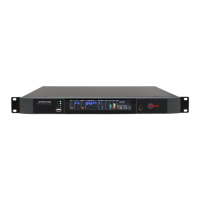Orban 5950 Technical Manual Operation 3-11
ITU-R 412 Compliance for Analog FM Broadcasts
ITU-R 412 requires the “average multiplex power” to be limited to a standard value. The 5950 contains a
defeatable feedback multiplex power limiter that constantly monitors the multiplex power according to ITU-R 412
standards. The power controller automatically reduces the average modulation to ensure compliance. It allows you
to set the “texture” of the processing freely, using any preset.
If a given processing setting would otherwise exceed the multiplex power limit, the power controller automatically
reduces the drive to the peak limiting system. This action retains the compression texture but reduces distortion
while controlling multiplex power.
The 5950 gives you control over the Multiplex Power Threshold (in the Input/output Utilities screen). This allows
you to compensate for overshoots in the signal path upstream from the 5950, preventing excessive reduction of
the multiplex power.
Power control is applied to all outputs, not just the composite output.
Two-Band Purist Processing
In addition to five-band processing, suitable for pop music and talk formats, the 5950 offers a very high-quality
two-band algorithm. This is phase-linear and features the same AGC as the five-band processor, followed by a two-
band processor with look-ahead limiting. Sophisticated multiband high frequency limiting and distortion-cancelled
clipping complete the chain.
We believe that this is the ideal processing for classical music because it does not dynamically re-equalize high
frequencies; the subtle HF limiter only acts to reduce high frequency energy when it would otherwise cause
overload because of the FM pre-emphasis curve. We have heard four-band, allegedly “purist” processing that
caused dynamic HF lift. This created a strident, unnatural sound in strings and brass. In contrast, the 5950’s two-
band phase-linear structure keeps the musical spectrum coherent and natural.
The look-ahead limiter prevents speech from being audibly clipped and prevents similar audible problems on
instruments with rapidly declining overtone structures like grand piano, classical guitar, and harp.
Digital Radio Processing
Only the phase rotator, highpass filter, AGC, and Multipath Mitigator are common between the FM analog and
digital radio processing chains. The processing chain splits into two paths after the AGC. Each path contains a
structurally identical but independently adjustable equalizer and multiband compressor. Each preset has an FM-
>HD CONTROL COUPLING control that determines if audio controls affecting the HD equalizer and HD multiband
compressor/limiter will follow their counterparts in the FM analog processing chain or if the HD and FM controls
can be adjusted independently.
The peak limiter in the digital radio processing chain is a mastering-quality lookahead limiter. This limiter
minimizes IM distortion in addition to minimizing harmonic distortion. The resulting peak limiting is almost always
undetectable when used with reasonable amounts of gain reduction (i.e., frequently recurring gain reduction of 3-
4 dB).

